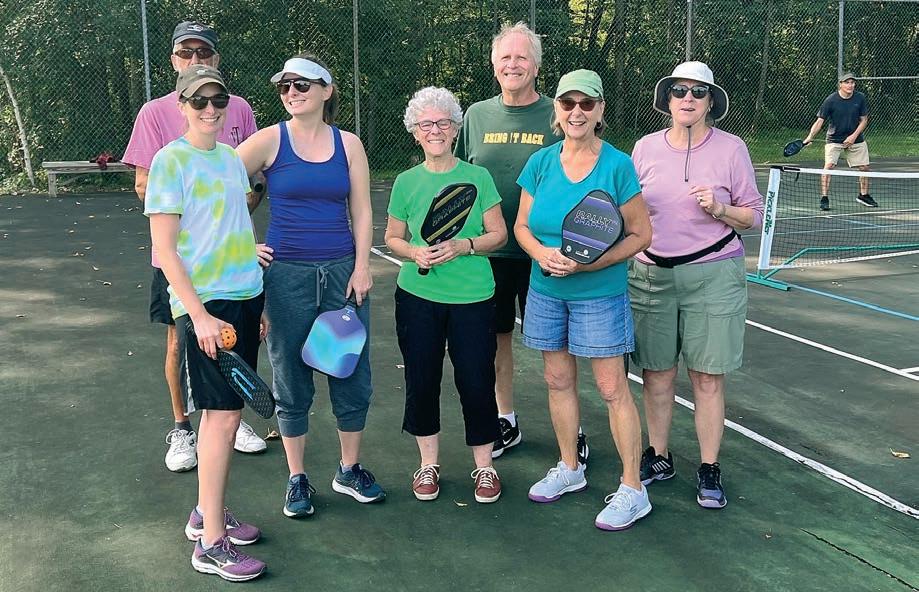Pickleball, anyone?



STAFF
To increase student diversity, the Shelburne Craft School is partnering with Age Well to offer “Weaving Your Story,” a fibers class that allows older adults and caregivers a space to reflect and celebrate people, memories and specific key milestones that have shaped the course of their lives.

“I’ve always been a huge fan of the work that Age Well does, and we were hoping to have courses filled with people of greater diversity than we typically pull at the school,” the school’s executive director, Heather Moore,
The future of more than 15 positions in the Champlain Valley School District may be at risk as federal COVID-19 relief funds run out.
About $1.5 million in ESSER funds, or Elementary and Secondary School Emergency Relief funding, is set to expire in September 2024, presenting a challenge as the district begins work on its fiscal year 2025 budget in coming weeks.
noting it has more than doubled its offerings and local partnerships in recent months. “We were looking to find students that had different socio-economic backgrounds.”
Age Well is the leading local area agency that advocates for the aging population in Vermont and is responsible for providing free nutritional counseling, case management and Medicare counseling.
“We’re tasked, in a very lovely way, with supporting older adults, 60 and over,” Tracey Shamberger, Age Well’s director of business development and communications, said.
Age Well’s services are free
and its main focus is to keep older adult at home by providing nutritional counseling, case management and Meals on Wheels.
In the classroom
Fiber arts teacher Bradie Hansen, a licensed therapist, guides participants in creating an individual time capsule that represents the different facets of each of their stories.
“The idea here is that anybody coming to the class is invited to think about whatever it is that they are going through, what transition
ESSER funds have supported approximately 17 additional school counselors, social workers and interventionists throughout the district’s five schools, and have funded new assessment systems and other education software and expanded summer programs. How and if the district can absorb those positions into its general operating budget for the 2024-2025 school year is still unclear.
“We know that’s going to be a driver of difficult decisions, tough discussions, and it’s going to leave a mark,” Gary Marckres, the district’s chief operations officer, said.

The Champlain Valley School District faces a daunting task in the next five years thanks mainly to the effects of Act 127 — but further exacerbated by the end of ESSER funds, as well as the increasingly immediate need to rehabilitate its aging buildings.
Act 127, Vermont’s new education formula signed into law last year, corrects what researchers at University of Vermont and Rutgers University showed was an insufficient pupil weighting system for low-income students or non-English speaking students. The new formula tries to correct that, but because of the shift, several districts that have historically benefited from the weighting — Champlain Valley, South Burlington, Essex and Mount Mansfield Unified Union among them — are now facing dwindling student counts, meaning those districts will eventually have to start raising taxes or cutting spending to fill in the gap.
Because of this, the Champlain Valley School District, which includes Hinesburg, Charlotte, Shelburne, Williston and St. George, is facing a budget hole that will either need to be raised through a 16 percent homestead tax rate increase, or by dramatically cutting spending.
Coupled with the ESSER funding, the district will face tough choices over whether to cut programs or institute a hefty tax increase for residents of the five Chittenden County towns.
The new education formula provides for a cap of 5 percent per year through fiscal year 2029 to ensure tax increases are not overly onerous, giving the district some
 SHAUN ROBINSON VTDIGGER
SHAUN ROBINSON VTDIGGER





Green Mountain Transit riders can expect slightly higher fares — and new ways to pay them — starting early next year on many of the bus system’s busiest routes.
For the first time since the onset of the COVID-19 pandemic, the transportation agency plans to start charging for rides on its local and commuter routes in Chittenden County, and LINK Express routes to Montpelier and St. Albans, effective Jan. 2. The agency has operated all its bus routes statewide fare-free since March 2020.
While Green Mountain Transit leaders have publicly discussed the return of fares since January, the agency shared more details this month about what riders can expect.
A ride on the local, commuter and LINK Express routes is set to cost $2 next year. That’s a 50-cent increase over the pre-pandemic fare on local Chittenden County routes, but equal to the previous fare on commuter routes. It’s also a $2 decrease to the fare on LINK Express services versus March 2020.
Clayton Clark, the agency’s general manager, said bringing back fares — and for some routes, increasing them — will help the transit agency make up for the impending loss of federal COVID19 relief funding that has buoyed its coffers the agency throughout the pandemic.
The transit agency’s roughly $25 million annual budget is funded largely with federal and state dollars, but also local assessments on the cities and towns its buses serve. Clark said that fare revenue — estimated to total about $1 million in its first year back —
will help keep local taxpayers from picking up a larger share of the tab.
“Nothing is as good as free,” Clark said in an interview, but reinstating fares “will really mean that we won’t have to jack up the prices to the municipalities.”
While ridership on the agency’s local routes in Chittenden County has largely returned to pre-pandemic levels this summer, the system’s commuter and LINK Express buses still are seeing far fewer riders than they were before the pandemic, the agency said.
The local routes saw about 132,000 total rides in June, according to the agency’s most recent ridership data online, but commuter lines saw only about 6,200 trips that month.
A proposed fare plan states that the agency has seen fewer people taking its commuter routes and the LINK Express services to and from their jobs in recent years; instead, most riders are using them to get to medical and human services appointments.
When fares come back, the agency plans to charge a reduced rate of $1 to riders who are under age 17, over age 60 or who have a disability. It also plans to continue operating its rural services — those in Washington, Lamoille, Franklin and Grand Isle counties — farefree, according to Clark.
Green Mountain Transit had planned to reinstate fares on its Chittenden County routes in July, but the agency said it needed more time to get its fare collection system up and running.
Now, Clark said the agency has started installing new fareboxes that, for the first time, will allow riders to pay onboard with a credit card or a smartphone, instead of
just cash and coins. Clark said that while 90 percent of bus riders likely have smartphones, it was important, from an equity perspective, to continue allowing onboard cash payments.
Under the new system, called Genfare Link, riders will be able to download a mobile ticketing app and, when boarding a bus, open the app and wave their phone over the farebox to pay.
Riders who do not, or cannot, use the app will be able to get a physical bus pass at a Green Mountain Transit center, which works in much the same way. At first, the pass would need to be refilled at a transit center, but Clark said plans are for riders to be able

to add money to the card at local stores, such as CVS and Walmart, in the future.

Clark said riders who use the Genfare system would also be eligible for a new, planned fare structure that caps the amount riders spend in a given period of time.
The transit agency plans to introduce a daily cap of $4 (or $2 for reduced-price riders), meaning riders would not need to pay after taking two trips in a day. Riders would also be capped at paying $40 (or, for reduced fares, $20) in a month — the equivalent of 20 bus rides.

Clark said these caps were created so that, even with a higher


All Republican Voters of the town of SHELBURNE, County of CHITTENDEN are hereby notified, in accordance with 17 V.S.A. § 2303, to meet in caucus on SUNDAY, SEPTEMBER 10, 2023 at the PIERSON LIBRARY, Merrill Community Rm at 4:30 PM.








The Agenda for this Caucus is as follows:

I. Pledge Allegiance
II. Election of Town Committee
III. Election of Officers by the Town Committee
IV. Election of County Committee Members

V. New Business







Susan Bowen Chair, Shelburne Republican Committee, ShelburneGOP.org
fare in place, regular bus riders would not pay more than the $40 cost of a monthly bus pass on the system’s local routes pre-pandemic. Monthly passes were more expensive for commuter lines.
Clark said the agency will be encouraging riders to take advantage of the new caps.
Sandy Thibault, executive director of the Chittenden Area Transportation Management Association, said her organization — which advocates for public transportation use in the county — was glad to see more modern payment options being put into place.
She said having the same fare across local and commuter routes will “provide, I think, more consistency for people traveling within the region,” adding that “we’ve got to make it easy” to take the bus for more people to consider a bus over driving a car.
A January report found that Green Mountain Transit could expect to lose more than 15 percent of its riders if it started charging again. Clark said he hopes the new fare caps will help keep the bus affordable to more people and limit the impact on ridership.
Green Mountain Transit held a series of public meetings on the proposed new fare plan earlier this month. Clark said agency leaders did not hear any objections to the plan, though noted that attendance at the meetings was extremely low across the board.
Clark added that while Green Mountain Transit’s board of commissioners may make some tweaks to the plan, he expects few major changes before it goes into effect.
you’re considering clear aligners, retainers or today’s braces, an orthodontist is the smart choice. They have 2 to 3 years of education beyond dental school. So they’re experts at helping you get a great smile—that feels great, too.




For yet another summer, volunteers of all ages hopped in kayaks and canoes to remove European frogbit, a non-native invasive plant species that spreads rapidly in bays and wetlands if given the opportunity.

In 2007, Lewis Creek Association initiated the Water Quality Stewardship Program and has since worked annually to manage the invasive plants and water quality of the rivers and streams that drain directly into Lake Champlain. The volunteer-driven project is the result of cooperation between many individuals and groups, including the towns of Charlotte, Shelburne and Hinesburg, Shelburne Bay Boat Club and a Charlotte property owner.
European frogbit, a common aquarium plant, spread to the United States via the St. Lawrence River after it was introduced to arboretum ponds in Ottawa in 1932. It is now considered an aquatic invasive species because it dominates native species in the competition for sunlight, nutrients and surface area.
Volunteer efforts have proven highly successful since frogbit was discovered in 50 percent of Town Farm Bay in 2007. Annual paddling and weeding trips, with a side of bird- and turtle-watching, have reduced the coverage of frogbit to just under 4 percent. In contrast, when frogbit was discovered in the wetlands of the LaPlatte Natural Area, it had a much lower percentage cover, which gave Lewis Creek Association volunteers the opportunity for early detection, rapid response. Though the invasive plant will never be eradicated in either location, maintaining this low population allows native plants and animals to thrive.
This summer, volunteers spent 189 hours removing 600 pounds of frogbit from Town Farm Bay, nearly half the amount harvested in the summer of 2022. Volunteers spent nine hours harvesting 60 pounds of frogbit, twice the amount from last year, in the LaPlatte River wetlands. Overall, the presence of frogbit was significantly less than the previous summer.
Multiple precipitation events throughout the month of July impacted the water level of Lake Champlain, greatly increasing the amount harvested by volunteers. Frogbit became more visible to volunteers because the higher water levels submerged the native lily pads (Nymphaea odorata), which cover much of the water
surface area. High water levels also allowed volunteers at the LaPlatte River wetlands to paddle into a previously inaccessible area to boaters; this area produced the majority of frogbit harvested at this location, likely because volunteers were unable to harvest from this area during previous summers. Though water levels increased visibility and access to frogbit during July 2023, the overall poundage was around 40 percent less than the amount harvested last summer.
The water quality stewardship program also includes the annual monitoring of water quality in the LaPlatte River, Patrick Brook, McCabe’s Brook, Thorp Brook, Kimball Brook and Lewis



Creek, by volunteers for South Chittenden River Watch. The program is important for maintaining productive, functioning and scenic waters, and also allows residents of Charlotte, Shelburne and Hinesburg to become advocates for water quality. Volunteers in each town help share this information with neighbors and friends, helping improve water quality in the future. For more information, reach out to Kate Kelly at lewiscreekorg@gmail.com or 802-4885203.
Kate Kelly is Lewis Creek Association program manager and Portia Butrym is an association contractor.



More than 34,000 Vermonters belong to a union. That’s 12 percent of our workforce.
Unions are shown to increase gender and racial parity, strengthen democracy in the workplace and enhance the compensation and well-being of workers. That is why supporting collective bargaining and union organizing is one of our best tools for building a strong workforce.
This past session, the Senate advanced the Vermont Protect the Right to Organize Act, which would give more Vermonters the opportunity to join or form a

union without fear of retaliation or overexposure. We also advanced sweeping access to affordable child care and took steps forward to implement paid family and medical leave. Labor Day is about recommitting to giving workers the dignity and respect they deserve. Because when we do, we create a tide that lifts all boats. So today, alongside labor partners like the Vermont ALF-CIO, I am committed to ensuring the Protect the Right to Organize Act passes the House and is signed into law by the governor. I am committed to advancing paid family and medical leave. I am committed to a strong safety net for all workers.
Everyone, regardless of which industry or sector they work in, deserves basic respect and dignity in the workplace, which includes freedom of conscience and respect of their right and choice to form a union with their colleagues.
This Labor Day, I thank unions and workers by recommitting to their strength, vitality, growth and well-being. For my family, for all our families.
Kesha Ram Hinsdale, a Democrat from Shelburne, serves the towns of South Burlington, Shelburne, Charlotte, Hinesburg, Milton, Burlington, St. George, Westford, Underhill, Jericho, Richmond, Winooski, Williston, Essex and Bolton in the Legislature. She is chair of the Senate Committee on Economic Development, Housing & General Affairs.

The Rotary Club of Shelburne, Charlotte and Hinesburg golf ball drop returns Friday, Sept. 15. Proceeds support fire and rescue services in Charlotte, Hinesburg and Shelburne, where in the past year crews responded to more than 2,000 calls for help. The fundraising event takes place from 4-6 p.m. at the Kwini Club Driving Range, 5353 Spear Street, Shelburne. All labeled balls will be dropped from a local helicopter courtesy of sponsors Beta Technologies and Kwini Club Driving Range. More than $2,000 in prizes will be awarded and only 1,500 golf balls will be sold. There will also be long-drive

Serving the community of Shelburne
A publication of Vermont Community Newspaper Group LLC shelburnenews.com
Advertising Wendy Ewing wendy@shelburnenews.com (802) 985-3091 x12
Advertising Director Judy Kearns judy@otherpapersbvt.com (802) 864-6670 x21

News Editor Tommy Gardner
Staff Writers Aaron Calvin Corey McDonald Liberty Darr
Production Manager Stephanie Manning stephanie@shelburnenews.com
Editor/Publisher Gregory Popa gpopa@stowereporter.com



The Shelburne News
Billing inquiries Leslie Lafountain leslie@stowereporter.com (802) 253-2101


Advertising submission deadline: Friday at 5 p.m. advertising@shelburnenews.com classifieds@shelburnenews.com
Editorial submission deadline: Friday at 5 p.m. news@shelburnenews.com
Calendar submission deadline: Friday at 12 p.m. news@shelburnenews.com
Contact: 1340 Williston Road South Burlington, VT 05403 (802) 985-3091







Beatrice Margaret Dolan Precourt, 95, of Shelburne, died on Thursday, Aug. 31, 2023, at her home surrounded by her loving family.
She was born in Portland, Maine, on Sept. 20, 1927, beloved daughter of Edward and Rita (Delcourt) Dolan. On Aug. 25, 1951, she married Rinald (Ray) George Precourt of Saco, Maine, at St. Mary Catholic Church in Westbrook, Maine.

Together they raised six children: Raymond, Michael, Patricia, Brian, Edward and Steven.
Beatrice graduated from Cathedral High School in Portland, Maine, in 1945, and from Gorham State Teachers College in 1949. Beatrice’s love for education was such a huge part of her life. She was a dedicated teacher, holding several different teaching positions throughout her long career.

She started teaching kindergarten and third grade in Saco and then taught 4th grade at Oceanside Elementary when Ray was stationed at Fort Pendleton in California.


They moved to Portsmouth, N.H., where she was a first-grade teacher at the Sherburne School. In Bristol, N.H., Bea taught sixth grade at the Bristol Elementary and on their final move to Shelburne in 1965 Bea taught both first and second grade at the Charlotte Elementary School for 20 years.
She left a little piece of her heart there with her dear friends and colleagues. Both she and Ray possessed a very strong work ethic. Outside of teaching, Bea was the “B” in the BandR Electric Company, which she and Ray started in 1972.
Beatrice was an immensely loving, kind wife, mother, grandmother, great-grandmother, sister, aunt and friend. She really enjoyed spending time with her family and loved to have everyone get together for dinner, birthday parties and holidays.
Her Catholic faith was such an important part of her life and legacy for her family, praying often for all of us and anyone else in need. She enjoyed traveling with Ray after their retirement to Hawaii, Bermuda, Ireland, England, Maine and many other places.
As a teacher, her love of reading remained with her until the end, reading the newspaper, magazines and nonfiction books — she didn’t have time for fiction — and, of course, her word puzzles. Bea’s independent spirit and large family allowed her to live on her own, until the end in the house she and Ray built
together.
Some of her happiest memories were growing up on a farm in Gorham with her parents and sisters. She always felt blessed to have met Ray at the Buxton square dance in 1948, and later build a family with him. Returning to Maine to visit her family and spend lots of time at the beach was a highlight of her summers. She rarely missed attending her children’s and grandchildren’s sporting events.
Beatrice leaves behind her children, Raymond (Mary), and their children, Ian and Julia; daughter-in-law, Mindy and her children, Scout (son Michael, daughter Montie), Samantha (Andromeda) and Thomas; Tricia (Jonathan) and their children, Brianna (Keith, sons Kieran and Kai), Kellen and Alainna; Brian (Alison) and their children, Megan, Joseph (Heather) and Alexander; Edward (Jo-Anne) and their children, Justin (Allison, son Greyson) and Mitchell; and Steven (Susan) and their children, Nicole, Brendan and Kristen; her sisters-in-law, Rachel Turnage and Rita Bourgeault; brother-in-law, Leo (Millie) Precourt; and numerous nieces and nephews.
She was predeceased by her husband, Rinald; her son, Michael; parents, Edward and Rita Dolan; sisters, Louise Laliberty and Anna Landry; sisters-in-law, Jacquelyn Desaulniers, Irene Precourt and Rita Precourt; brothers-in-law, Arthur Laliberty, Raymond Landry, Edmond Precourt, Fernand Precourt, Norman Precourt, Paul Precourt, Gerard Precourt, Lawrence Precourt, Robert Precourt, Ernest Precourt and Victor Desaul-
niers.
The family would like to thank the many health professionals for their expert and compassionate care over the years, especially Dr. Joseph Winget, Dr. Susanna Thach and University of Vermont Hospice, specifically Judy Johnson.
A Mass of Christian burial will be held at St. Catherine’s Church in Shelburne on Saturday, Sept. 9, 2023, at 10 a.m. Visiting hours will be held at the Ready Funeral Home, South Chapel, 261 Shelburne Road, Burlington, on Friday, Sept. 8 from 5-7 p.m.
In lieu of flowers donations can be made to Shelburne Food Shelf, PO Box 763, Shelburne VT 05482, or UVM Health Network
Home Health and Hospice, 1110 Prim Road, Colchester VT 05446.

Arrangements have been entrusted to the care of Ready Funeral and Cremation Service. Online condolences may be made at www.readyfuneral.com.

Betsy Ann Bouton
Betsy Ann (Bigelow) Bouton, 95, of Shelburne, died peacefully on Saturday, Aug. 12, 2023.


She was born on July 4, 1928, to Drs.
See OBITUARIES on page 7

Join Shelburne’s Pierson Library on Thursday Sept. 14, at 6:30 p.m., for reading and conversation when “Our Better Nature” authors Alicia Daniel and Curt Lindberg headline a fun, family friendly event.
Alicia Daniel is executive director of the Vermont Master Naturalist Program and Lindberg, an editor, is founder for the Vermont Alliance for Half-Earth.
Community Concerts @ First will present Bethany Blake on harpsichord and organ on Sunday, Sept. 24, 7-9 p.m., First Congregational Church of Essex Junction, 39 Main St.
The program will feature music by French and German composers, including Bach, Couperin and Rameau. Concert proceeds will support the Committee on Temporary Shelter and First Congregational Church of Essex Junction. Tickets are available online at bit. ly/3qYKXNC.
Age Well and St. Catherine’s of Siena Parish in Shelburne are teaming up to provide a meal to go for anyone age 60 and older on Tuesday, Sept. 12.

The meal will be available for
pick up in the parking lot at 72 Church St. from 11 a.m. until noon and are available for anyone 60 or older. Suggested donation is $5.
The menu is Swedish steak with mushroom sauce, seasoned penne pasta, broccoli, wheat bread, vanilla fluff with blueberries and strawberries and milk.
To order a meal contact Kathleen at agewellstcath@gmail.com or 802-503-1107. Deadline to order is Wednesday, Sept. 6.
The Burlington Garden Club is sponsoring a “lollapalooza” of a Yard Sale on Saturday, Sept. 16 from 8 a.m.-2 p.m. at the Faith United Methodist Church at 899 Dorset St., South Burlington.
Proceeds will go to the club’s
Join Secretary of State Sarah Copeland Hanzas on Wednesday, Sept. 13, 4:30 to 6:30 p.m., to celebrate the placement of a painting by South Burlington artist Cynthia Cagle. The painting, “The Light of Truth Upon Them,” is an original suffrage-focused painting commissioned by the Vermont Suffrage Centennial Alliance as part of its commemoration of the 19th Amendment’s centennial. Cagle combines the struggles of Indigenous, Black, Latina and Asian people and the history of the fight for the vote and her painting showcases the perseverance of those who stood up — who stand up — in the face of injustice in Vermont and across the country. As an artist with indigenous ancestry, Cagle’s art confronts notions of progress. When one group moves forward towards independence and autonomy, often another is left behind, such as Native Americans. The painting depicts Zitkala-Ša, Mabel Ping-Hua Lee, Stacey Abrams, Ida B. Wells, Lucy J.C. Daniels and Louvenia Dorsey Bright. It will hang in the office of the Vermont Secretary of State. RSVP at bit.ly/3EsZnbK.


scholarship program for outstanding students in the plant and soil science department of the University of Vermont, as well as other community projects the club funds.
“Many of our members have donated some stunning items for the sale, including antiques, small
appliances, cookware, small pieces of furniture, gorgeous vases, flowerpots and gardening tools, artwork, linens, dishes, lamps, some fabulous jewelry, and much more” club co-president Linda Lane said.

Additional information and photos of yard sale items are avail-
Performed by Our Master Jewelers | Same-Day Repair When Possible Ring Sizing • Cleaning • Stone Tightening • Rhodium Plating


Performed by Our Graduate Gemologists
able on the Burlington Garden Club Facebook page. For more information, bgcvt.org.
Last month garden club members around Vermont donated and collected donations of hundreds of planters and fresh plants, which members planted and drove to Barre to offer to local businesses which had lost all their potted plants in the flooding and debris.
Other Vermont garden clubs are digging in to do their part with their dedication to sustaining national and urban forests. The clubs raise donations from club members to replant disaster-struck forests.
The clubs work in partnership with the National Garden Club and the U.S. Department of Agriculture. The project began in 1941 as a conservation project.
To learn more, gardenclub.org/ penny-pines.
Shelburne church hosts Red Cross blood drive
St. Catherine of Siena Parish is holding a blood drive Tuesday, Sept. 19, noon-5 p.m., 72 Church St., Shelburne.
To sign up, call 800-733-2767 or visit redcrossblood.org.
The Hinesburg Fall Fest returns Saturday, Sept. 23.
Festivities begin at 10 a.m. with No Strings Marionette Company puppet show at the United Church Parish Hall. The action continues from 11 a.m.-2 p.m. at the Town Common on Route 116 behind the police station with music, food, vendors and activities. At 6 p.m. all are welcome to Stone Soup Supper at the United Church Parish Hall. Tickets are $10 for adults $10; free for kids under 12.
Visit the fall festival to connect with local businesses and organizations, relax and listen or kick up your heels and dance as local musicians share their talents,
OBITUARIES
continued from page 5
Nelson S. and Elizabeth (Freeman) Bigelow. Her family bought a farm in Landgrove where they moved during World War II and where she met her future husband, Edward Lane Bouton. They married in 1949.
She graduated with honors with a degree in horticulture from University of Vermont in 1950. Betsy believed in education and considered herself a life-long learner. She loved the arts in all forms and passed down an appreciation for them to her children and grandchildren.
She raised three children and became “Mom” to three German and a Zambian student, all of whom she hosted, cared about and took pride in throughout her life.
During this time, she was an active member of several organizations, including the Vermont Girl Scout Council and East Montpelier School Board, and she served as chairman of the Washington Central Supervisory Union Board. She also taught English to non-native speakers.

After her children were grown, Betsy cultivated a growing passion for the built landscape, especially Vermont’s, and went on to obtain a master’s degree in historic preservation from UVM in 1979. Later, she became curator of the Kent Museum in Calais.
Betsy was also a field surveyor and photographer for research on the Vermont Statehouse and served on the board of Friends of the Vermont State House where she was a guide and member of the restoration committee. She worked as a docent
enjoy lawn games, art activities and fall-themed storytimes, and food from local eateries including Hinesburgh Public House, Las Hermosas, Good Times Cafe, Papa Nick’s and Bushel Market.
Please take advantage of Hinesburg’s walkable village center by parking at town hall, the United Church and the cheese plant, all on Route 116; National Bank of Middlebury, Hinesburg Animal Hospital and Nestec, all on Commerce Street; and WCVT on Mechanicsville Road.
There is limited parking behind the fire station (accessible via Farmall Drive) and handicapped parking is available at the police station.
at the Shelburne Museum, and was author or co-author of several publications, including “A Walk Through Montpelier,” “East Montpelier Bicentennial Souvenir Booklet,” “The Vermont State House: A History and Guide,” as well as slide shows of the Barre Opera House, and the town of Randolph.
Once she retired, she became an avid hooker — as in rugs! — one of which, Tumbling Cats, was chosen as a cover of the Association of Traditional Hooking Artists newsletter. She hooked rugs for each of her grandchildren.
She was predeceased by her husband of 67 years, Edward Lane Bouton, in 2016.
She leaves behind her three children and spouses, Jonathan Bouton (Judi Simon-Bouton) of Hartford, Margaret (Peggy) Irons (Paul Irons) of Berlin, and Timothy Bouton (Barbara Torian) of New Haven; grandchildren, Liza Bouton of Cambridge, Micah Bouton and wife, Emily Fiorelli and children, Joey, Bella and Jon of Hartford, Jason Irons and wife, Joelle and daughter, Charlie of High Point N.C., Jesse Irons and wife, Emily Dahl Irons and daughter, Isabelle of Melrose, Mass., Josh Irons and wife, Melissa Miles and stepsons, Liam and Roan Sirvent of Montpelier, and Andrew Bouton of New Haven.
Those who wish may make memorial contributions in her memory to “Friends of the Vermont State House, 126 State St., Montpelier VT 05602 (friendsvtstatehouse.org); or to the charity of your choice.




Adding shrubs to your landscape can have many benefits. After being planted, they can live for many years. They visually ground gardens, adding structure throughout the year. Perhaps most importantly, they can provide food and shelter for small mammals, birds and insects.
Native flowering shrubs also can attract and support pollinators in your garden. There are many fantastic flowering shrubs that you can add that will appeal to pollinators and beneficial insects.
One of my favorites (which makes an appearance in almost every one of my planting plans) is red-twig dogwood (Cornus sericea). Growing over 6 to 8 feet tall and wide, red twig dogwood is a native shrub that thrives in wet and dry conditions and in full to part sun.
Dogwood’s red twigs bring color to the bland winter landscape and attract pollinators to its white flowers in spring. Fruits from this shrub are also attractive to birds. Red twig dogwood’s roots are strong and can help prevent erosion and stabilize slopes.
Willows such as pussy willow
(Salix discolor) are great bank stabilization plants. They are one of the earliest shrubs to flower, so they provide a great service at a time with limited food options for pollinators.
Pussy willows can be trimmed as shrubs or allowed to grow into small multi-stem trees, growing 6 to 15 feet tall and 4 to 12 feet wide. Their wispy foliage provides a unique texture to the garden. They prefer medium to wet soils, and full to part sun.
Another excellent pollinator plant for the garden is viburnum. American Cranberry Bush (Viburnum opulus var. americanum) has showy, white flowers in the spring, growing 8 to 12 feet tall and wide. Its brilliant red berries are edible for birds and people alike. This pollinator shrub prefers full sun to part shade and medium soil moisture.
A native spiraea, steeplebush (Spiraea tomentosa), has pink, upright plumes that grow up to 5 feet tall. Steeplebush prefers moist soils and full to part sun. Seen in the wild, this spiraea and its relatives (Spiraea alba and Spiraea tomentosa) are excellent pollinator plants that would be a
See POLLINATORS on page 9

continued from page 8
unique addition to the home garden. There are many more wonderful, native shrubs that attract pollinators. Check out the University of Vermont Extension Master Gardener Garden Resources

webpage (go.uvm.edu/garden-resources) for more plant ideas.






Bonnie Kirn Donahue is a UVM Extension master gardener and landscape architect from central Vermont.



The Champlain Valley girls’ cross-country team opened the season with a first-place finish at the Essex Invitational Saturday, Sept. 2, after placing six runners in the top 10.
Estella Laird was the top
finisher, while Alice Kredell came in second. Lydia Donahue was fourth, Audrey Neilson was sixth and Charlotte Crum came in seventh place. Annalise Wood also finished in the top 10, placing eighth.
For the boys, Champlain Valley finished in fifth place. Owen Deale was the top finisher, in 10th. Kody Guiternam was 21st, Charles Garavelli was 22nd

Finishing up digging projects before the snow flies?
Before you dig, you or your contractor must contact Dig Safe™ at 811 at least 48 hours prior to digging.

Before the work begins, Dig Safe will notify member utilities, who will then ensure the locations of buried facilities they own are clearly marked. Please insist that any work within 18 inches of the marked lines be done by hand.



and Ethan Morris was 25th.
Burr and Burton 38, Champlain Valley 28: Champlain Valley was outscored in the second half as Burr and Burton handed the defending champs a loss in its season opener.
Ollie Cheer led the way for the Redhawks, going 14-for-29 with 262 passing yards, three touch-
down passes and one-yard rushing TD. But it wasn’t enough for CVU, which was outscored 24-14 in second half.
Brian Rutherford had seven catches for 152 yards and two touchdowns, while Jacob Armstrong added a touchdown catch.
Champlain Valley 12, Mount Anthony 0: Chloe Pecor led the way for Champlain Valley in an offensive outburst that helped the Redhawks to a 12-0 win over Mount Anthony on Friday, Sept. 1.
Pecor had four goals and one assist for CVU (1-0), while
The public bathroom at Shelburne Beach closed after Aug. 28. The beach will no longer be staffed for the season.
Smell: Natural gas is normally odorless. A distinctive, pungent odor, similar to rotten eggs, is added so that you will recognize it quickly.

Sight: You may see a white cloud, mist, fog, bubbles in standing water, or blowing dust. You may also see vegetation that appears to be dead or dying.
Sound: You may hear an unusual noise like a roaring, hissing, or whistling.
Move immediately to a safe location. Call VGS at 800-639-8081 or call 911 with the exact location. Do not smoke or operate electrical switches or appliances. These items may produce a spark that might result in a dangerous condition.
Do not assume someone else will report the condition.
If you plan to have a large group of 20 or more people, contact the recreation office to schedule as we try to limit large groups at the same day and time due to limited parking and restroom availability.
There will be one port-o-potty available at the end of the parking area at the beach through the end of September. Beach policies are still in effect, including no dogs or pets, Shelburne residents and their guests only, and carry out your trash.
Construction on the new beach house will begin on Tuesday, Sept. 5. The area will be fenced off so Shelburne residents may still use
Zoe Klein, Ella Knudsen, Ava Barron, Reese Kingsbury, Rieanna Murray, Natalie Webster, Lily O’Brien and Kate Roberts all added a goal.
Lily Williams and Lauren Knudsen each had two assists, while Anya Johnson earned the win in goal.
Champlain Valley 3, St. Johnsbury 0: Girls’ volleyball opened the season with a straight set win over St. Johnsbury Friday. The Redhawks won the first set, 25-11, and then the second 25-12 to take control. A 25-16 win in the third clinched it for CVU.
the park for picnics, lake access and the playground while construction is going on.
However, there will be trucks and equipment so use caution driving in and out of the facility and supervise children closely. We will post periodic updates.
Questions? Contact the Shelburne Recreation at 802-985-9551 or bcieplicki@shelburnevt.org.


Adult programs include men’s basketball, volleyball, table tennis, yoga, pickleball, beginning tai chi and more.
Youth programs include Brazilian jiu jitsu, Crossfit and basketball. Visit shelburnevt.org for program details and registration.
The roads are overflowing with peepers looking for great shopping, things to see and do, and places to dine in or take out. Let us help you reach the tens of thousands of visitors who come to play in the mountains surrounding Stowe, Cambridge and Morrisville and to explore the gorgeous Lake Champlain Valley and beyond.

Champlain Valley Union High School is no stranger to state titles, and the Redhawks have raised their share of trophies over the years. Last year, though, CVU marked some milestone moments.
The CVU girls soccer team captured the program’s 20th state title, making it the winningest soccer program in state history. The Redhawks field hockey team celebrated its first title in nearly 15 years. And the CVU football team won the program’s first-ever Division I state championship.

After a year holding the top spots, now these three Champlain Valley teams turn their focus to defending their titles.
It took an overtime period over rival South Burlington, but last year finally saw Champlain Valley break through to win the Division I title for the first time in 14 years. Now the Redhawks must turn their attention to the defense of their trophy.
They will have some work to do early in the season to figure out how to replace players that graduated after last season, including Miranda Oppenheimer, who scored the OT winner in the final, Tess Everett in the midfield and Danielle Gamelin on defense.
But CVU does have an experienced roster with five seniors and 10 juniors, so the defending champs will hope to keep the growing pains to a minimum. The Redhawks will look to senior Emily Gay and Claire Marcoe to produce on offense, while Cordelia Thomas will look to take over in the midfield as a sophomore.
Champlain Valley will open their season on Wednesday, Sept. 6, against Essex at 4 p.m.
While the other two CVU title winners are on somewhat new ground, the Redhawks girls soccer team is very familiar with the position in which they find themselves this fall.
After capturing the program’s 20th state title last year, the Redhawks are now in the hunt for No. 21 and they will do so with a very experienced group.
The team returns Chloe Pecor, the Burlington Free Press player of the year, Ava Barron anchoring the midfield and Stella Dooley steadying the defense. All in all, the Redhawks return 16 players from last year’s squad.
The team did face some early season struggles as weather and poor field condi-
tions made it hard to get a full preseason outside so the hope is that the rain holds off as the regular season gets underway so the team can find their feet outside.
The girls’ soccer season starts Friday, Sept. 1, at Mount Anthony. Kickoff is 4 p.m.
Champlain Valley finished last season in new territory, as Division I football champions. Now they start this season off in even more unfamiliar territory, as defending champs and the No. 1 team to beat.
The Redhawks will look to some key returning players to set the tone early, including quarterback Ollie Cheer, running back Jacob Bose and wide receivers Brian Rutherford and Jacob Armstrong, which should give the team some early chemistry on offense.
But CVU will need some time to find replacements for departed players, most notably Gatorade Player of the Year Alex Provost. And they will have to do it quick, as the Redhawks start the season off against another team expected to contend, Burr and Burton.
Champlain Valley opens its title defense on Saturday on the road at Burr and Burton at 1 p.m.
continued from page 1
CVU welcomed its field hockey team to the championship fold after their most recent season. time to prepare.
School administration officials hope to use the next five years, while the cap is still in place, to identify resources “that don’t align with our goals in the strategic plan or have become inefficient of obsolete,” Marckres said.
Administration officials have said they will begin requiring offsetting reductions for any new expenses.

Meanwhile, the district is beginning work on addressing its facilities, and will soon create a larger facility study committee — including board members, faculty and staff and other stakeholders from the broader community — as a starting point for a capital plan.
“Those three things are really going to be the main drivers of the fiscal year 2025


budget and the next five years and even beyond that,” Marckres said.
Bonnie Birdsall, the director of communications for the district, said administration officials, including Marckres and superintendent Rene Sanchez, will be working with school leaders and teachers to explain the implications of the loss of ESSER funds, and plan on visiting each school this month to share a presentation and engage faculty in conversations on the implications of the loss of ESSER funds.
Officials at a recent school board meeting said they will be reviewing and prioritizing those positions against the existing general fund spending.
“With our budget process starting within the month, this is among our top priorities now that school has begun,” Sanchez said.
On any Saturday afternoon, courts that once carried the racket of tennis have been overtaken by a game that has captured the soul of many Americans, including hundreds in Chittenden County: pickleball.

The sport, which has been around since the 1960s, is the fastest-growing sport in America, primarily due to its accessibility, fast-paced matches and comradery between players, on and off the court.
To the passing eye, the game looks like a mix of tennis and a large-scale ping-pong match as competing two-player teams whack a whiffle-like ball back and forth with plastic paddles.
While most people come to the sport out of curiosity, Charlotte resident Greg Smith said he found the game months after a debilitating back surgery that left him immobile.
“Literally, I was in a fetal position for six months,” he said. “The idea of just being out there and doing something was so wonderful.”
Smith, a tennis player at heart, explained that because of its similarity to other popular sports, picking up the game is relatively simple, and the short lengths of the matches make it much less likely to severely strain muscles.
“If you’ve had any experience at all with ping pong, badminton,
tennis, it’s a natural,” he said. “You’ll pick it up really quickly and what you see is people doing the same shots that you’re familiar with: dig shots, smashes, all these different types of strokes, you can pick them up quickly.”
He said that because the sport found immediate popularity in older age groups and those who are unable to play games like tennis anymore, the sport has gained traction in Vermont due to its aging population.
“This is just natural for those who can’t play tennis anymore or can’t run up Mount Philo or whatever. So, the sport is beautiful that way,” he added.
In Charlotte, the beach courts are now being used a lot less frequently for tennis and are instead being used almost daily by up to 30 avid “picklers.” In fact, some have estimated that the annual pickleball player hours at Charlotte beach is an estimated 10,384 hours. Assuming one-anda-half hours of play per visit, that equates to nearly 7,000 unique visits to these courts every year by players.
Smith is partially to blame for the increased pickleball traction in Charlotte since he initially introduced the sport to a group of residents almost 10 years ago.
“It’s a cantankerous bunch of people from about age 38 to 78,” he joked, noting that he refers to himself as the pickleball-meister.
“It’s diverse and what I’ve seen is a lot more young players are start-
ing to come in.”
In his group alone he has over 95 people currently on his weekly email list, but the list at one point was as high as 150 people. Other groups of 40 to 50 players have branched out into their own groups.
“I have to say, I’ve never seen a sport this contagious, really,” Smith said. “It’s a hell of a community-building enterprise.”
Earlier this month, the group successfully led a charge to convert one tennis court at the beach into two permanent pickleball courts and has successfully raised more than $6,000 to help pay for the switch.
During Vermont’s long winter months, Smith hopes to create an indoor league this year, but in past years players have kept the passion burning by playing polar pickleball.
“They play outdoors all winter in anything over 30 degrees or so,” he said.
Next door in Shelburne, the pickleball craze is in full swing, too.
Resident Len Gulino, a trained pickleball instructor, former USA Pickleball Ambassador, and pickleball tournament director, currently offers weekly clinics to beginners and intermediate players who may be looking to improve their technique.
“I actually love beginners because there always seems to
be a moment in that first session, about halfway through where all of a sudden, they have a great rally and somebody yells out, ‘Oh my lord, this is fun.’ I swear to God, it’s almost every session is like that.”
Gulino came to the sport in a similar way to Smith. With experience playing tennis and pingpong, he found the sport sometime in 2015 on a trip to Florida, a moment he describes as a reincarnation of sorts.
He spearheaded a pickleball group in New Hampshire — where he was living at the time — of about 250 players and later brought his skills to Shelburne when he and his wife moved to town in 2021.

“I was totally happy with retirement until COVID-19 hit and I was like, you know what, I’m not done. I’m too young. I’ve got more to offer the world.”
Gulino said the sport is unique in that people of all ages can compete against each other, something he could never have done in a sport like tennis.
“I routinely play with people in their 20s and 30s and I’m compet-
itive with them,” he said. “In tennis, there’s no way I could do that because it’s such a big court.”
The growth also prompted the Shelburne Selectboard to upgrade the Davis Park courts on Harbor Road to include permanent pickleball courts. The approved allocation of $100,000 in American Rescue Plan Act funding to the courts includes power washing, resurfacing and repainting the entire area, changing the layout to include four to six pickleball courts and four tennis courts, as well as some minimal fencing in between to prevent pickleball and tennis from rolling onto each other’s courts.
While the sport offers a fun way to stay active for a wide variety of demographics, Smith and Gulino both agree that more than anything, people from all walks of life are finding common ground through the game.
“It’s built relationships that didn’t exist before,” Smith said. “It’s connected people who didn’t know each other, and it’s eliminated a lot of the isolation that was here with us from the COVID-19 pandemic.”
To
a



throughout


Come work where you play! e Valley Reporter, a local, weekly newspaper serving the Mad River Valley as well as Sugarbush and Mad River Glen, is looking for a sta writer.









e ideal candidate will possess a curious mind, exceptional writing skills and an appreciation for small-town life. While a background in journalism is not required, the ability to write concisely and accurately is. is person will report on the people, places and events of the Mad River Valley, including local politics, education, sports, recreation, agriculture, business, cra beer, the environment and more. Must be detail and deadline oriented. A exible schedule is required; the individual will attend public meetings on some nights and weekends. Photography and social media skills required.
Send a cover letter, resume and two to three w ritin g samples to lisa@valleyreporter.com

Due Friday, September 15, 2023
Payments must be RECEIVED or POSTMARKED by MIDNIGHT, September 15, 2023. Late payments are subject to penalty and interest. Payments can be left in lock box at Police Department Dispatch until Midnight, September 15, 2023.

If it’s important to you or your community look for it in the Shelburne News.
RABIES BAIT


continued from page 2
The week-long bait drop is a cooperative effort between Vermont and the U.S. Department of Agriculture Wildlife Services to stop the spread of the potentially fatal disease.


Rabies is a deadly viral disease of the brain that infects mammals. It is most often seen in raccoons, skunks, foxes, and bats, but unvaccinated pets and livestock can also get rabies.The virus is spread through the bite of an infected animal or contact with its

saliva. If left untreated, rabies is almost always fatal in humans and animals. However, treatment with the rabies vaccine is nearly 100 percent effective when given soon after a person is bitten by a rabid animal.
So far this year, 23 animals in Vermont have tested positive for rabies, and 14 of those have been raccoons.



According to wildlife officials, rabid animals often show a change in their normal behavior, but you cannot tell whether an animal has rabies simply by looking at it. People should not touch or pick up wild animals or strays – even baby animals.

March 21 - April 20
Get outside and enjoy as much fresh air and exercise as possible this week, Aries. A weekly outdoors excursion can recharge the batteries and provide some time to re ect.
April 21 - May 21
Taurus, it’s not possible to have everyone like you all of the time. Emotionally it can be dif cult to accept that not everyone agrees with your point of view. Be who you are.
May 22 - June 21
Someone from your past might come back into your life, Gemini. Keep a lookout for someone who seems familiar, as it can be a way to reminisce for a bit.
June 22 - July 22
Cancer, start conversations with all of the people you meet so you can learn about different backgrounds or cultures. You might learn something you didn’t know or try a new food.
July 23 - Aug. 23
Leo, try to work the room when you are thrust into a social situation. You need to be a diplomat or politician if you want to be in good standing with as many people as possible. Put your best face forward.
Aug. 24 - Sept. 22
You know who you can trust, Virgo. Stay close to those people for the time being. Some dif culties with family members will arise and you may need to pick sides.
Sept. 23 - Oct. 23
Libra, after a whirlwind adventure, you may be glad to be back home. Vacations are nice and relaxing, but soon enough you may crave the familiarity of your own space.
Oct. 24 - Nov. 22
Scorpio, you a calm energy around you this week. You can rest assured that the people you are dealing with have everything handled. They take care of business.
Sudoku puzzles are formatted as a 9x9 grid, broken down into nine 3x3 boxes. To solve a sudoku, the numbers 1 through 9 must ll each row, column and box. Each number can appear only once in each row, column and box. You can gure out the order in which the numbers will appear by using the numeric clues already provided in the boxes. The more numbers you name, the easier it gets to solve the puzzle!
Nov. 23 - Dec. 21
There is a great opportunity knocking at your door, Sagittarius, so why not seize it? New things can be scary, but you have to dive in right now.
Dec. 22 - Jan. 20
Take stock of where you want to go in the future and start putting those plans together, Capricorn. You don’t have to gure everything out, but try to map out a rough outline.
Jan. 21 - Feb. 18
You can quickly see when someone is putting on an act, Aquarius. They may say one thing but mean another. This duplicity can be offputting, but try to get along with others right now.
Feb. 19 - March 20
Pisces, you are in no danger of not being popular right now, so continue to enjoy all of the invitations you receive. You also can be proactive and throw your own party for friends.
CLUES ACROSS
1. Second sight
4. Standard electrode potential
7. Type of gibbon
8. John Joseph __: American industrialist
10. Manning and Whitney are two
12. Abrupt
13. Baroque musical instrument
14. Post-burning residue
16. When you hope to arrive
17. Sign up (Brit. Eng.)
19. Sun up in New York
20. Employee stock ownership plan
21. Where people live
25. Method to record an electrogram
26. Angry 27. No longer living
29. Simple 30. Swiss river

31. Portion of a play 32. It’s under the tree 39. Wood sorrels

41. No (Scottish)
42. Dialect of English
43. Former Steelers’ QB
44. Popular beer
45. It can make you sick
46. Tropical tree and fruit
48. Company of cer
49. Contact lens term
50. Your consciousness of your own identity
51. “Ghetto Superstar” singer
52. Piece of turf
CLUES DOWN
1. Number of players on each side in a football game
2. Containing salt
3. Reasoning or knowledge: a __
4. Car mechanics group
5. Leave a place
6. Southern Colombian capital
8. Old English letter
9. Tide
11. Walk heavily
14. Chemical
compound (abbr.)
15. Arti cial openings
18. Luteinizing hormone










19. Unit of energy
20. Circular movement of water
22. A way of holding
23. Popular book of words (abbr.) 24. States’ group 27. Dashes 28. Body part 29. Electronic countermeasures 31. Consumed 32. Small bird 33. Unhappy 34. Football’s big game (abbr.) 35. Valued object offered in good faith 36. Wild goats 37. Precede in place 38. Small edible sh 39. Notice of death 40. Body cavity of a metazoan 44. Partner to cheese 47. Not around



CLASSES

continued from page 1
they’re going through, anything like that,” Hansen said.
Hansen came to fiber arts 15 years ago and found the meditative process of weaving row after row as a helpful mechanism for grieving the loss of her mother.


“I started to notice that most of the time I felt better or felt just really connected with myself and grounded after working on projects,” she said. “As a therapist, I couldn’t help but make the leap if I could start to build that into ways that I worked with people.”
The class creates space for participants to process difficult situations they may be going through while also reflecting on situations that have marked their lives, each symbolized by different yarn, charms or even articles of clothing brought from home that can be woven into the finished project.
“This helps bring an understanding of how they got from one place to another,” she said. “People are invited to use different symbols to mark things that happened along the way,” describing a piece she had created that has her mother’s favorite shirt sewn into it. “So, if someone’s going through a major life transition, that might have its own constellation of symbols. If somebody’s working on healing, and metabolizing grief, that will have its own symbols.”
Although the class is not exclusively centered around grief, that feeling is often one that surfaces the most.

“It’s like watching someone suddenly have something in their hands that they made that reflects their loved one who they longed for,” Hansen said.

Although the rhythmic motion of the weaving process often creates a group
silence, Hansen said that more often than not the classroom is filled with laughter and storytelling. On top of helping participants connect to past selves and lives, it also has created an outlet for new relationships and connections to blossom.
“A woman I spoke with said that she’s been looking for a program to connect with other people who are also experiencing grief,” Shamberger said. “What better way than to create something beautiful, meaningful and memorable with a group of people who understand exactly what each other is going through.”
In addition to issues like housing and food insecurity, Shamberger said that one of the greatest threats to older adults is social isolation and lack of connectedness.
“If you are socially isolated, your health deteriorates, that’s just a fact,” she said.
Hansen explained that more than anything, she hopes to bring a level of playfulness to some of life’s hardest battles.
“I’ve worked to make sure that there are a wild amount of options for people. Anything from straightforward yarn to stuff that’s wicked thick or sparkly with glitter and 18 shades of purple. I want people to walk in there to feel happy,” she said.

Moore noted that the outcome from person to person can be drastically different, but the process in some ways mirrors the reality of life.
“Talking to participants, they didn’t know what the finished product would look like coming in,” she said. “Sometimes, they didn’t even know what it would look like halfway through, just like your life in some ways.”
“I started to notice that most of the time I felt better or felt just really connected with myself and grounded after working on projects.”
— Bradie Hansen